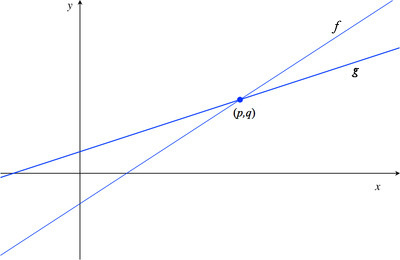Linear Functions
The figure below shows the graphs of the functions represented by $f(x)=4x-a$ and $g(x)=2x+b$ for some constants $a$ and $b$. They intersect at the point $(p,q)$.

- Label the graph of $f$. Do the same for the graph of $g$.
- What do $a$ and $b$ represent in the graphs above?
- Imagine you place the tip of your pencil at point $(p,q)$ and trace the graph of $f$ out to the point with $x$-coordinate $p+2$. Imagine I do the same on the graph of $g$. How much greater would the $y$-coordinate of your ending point be than mine?

